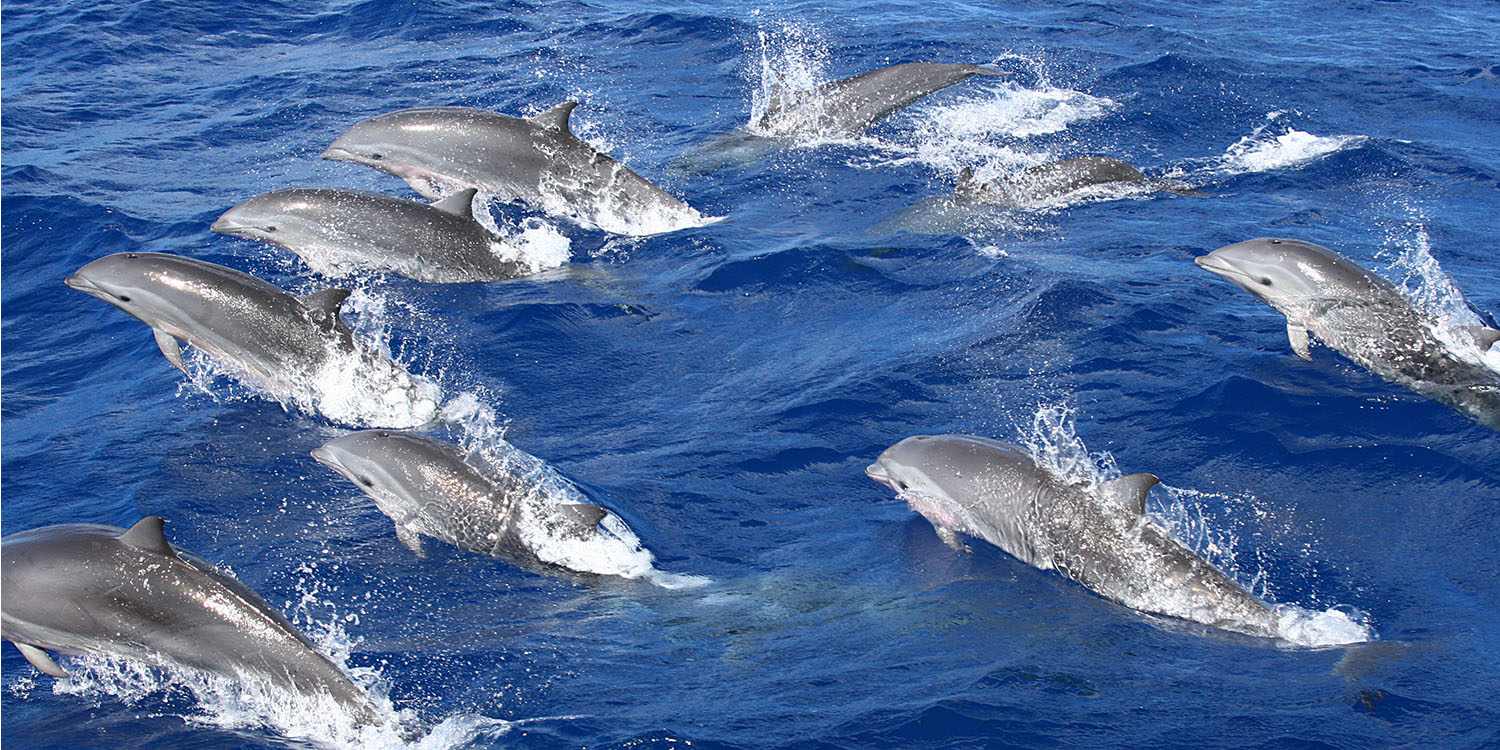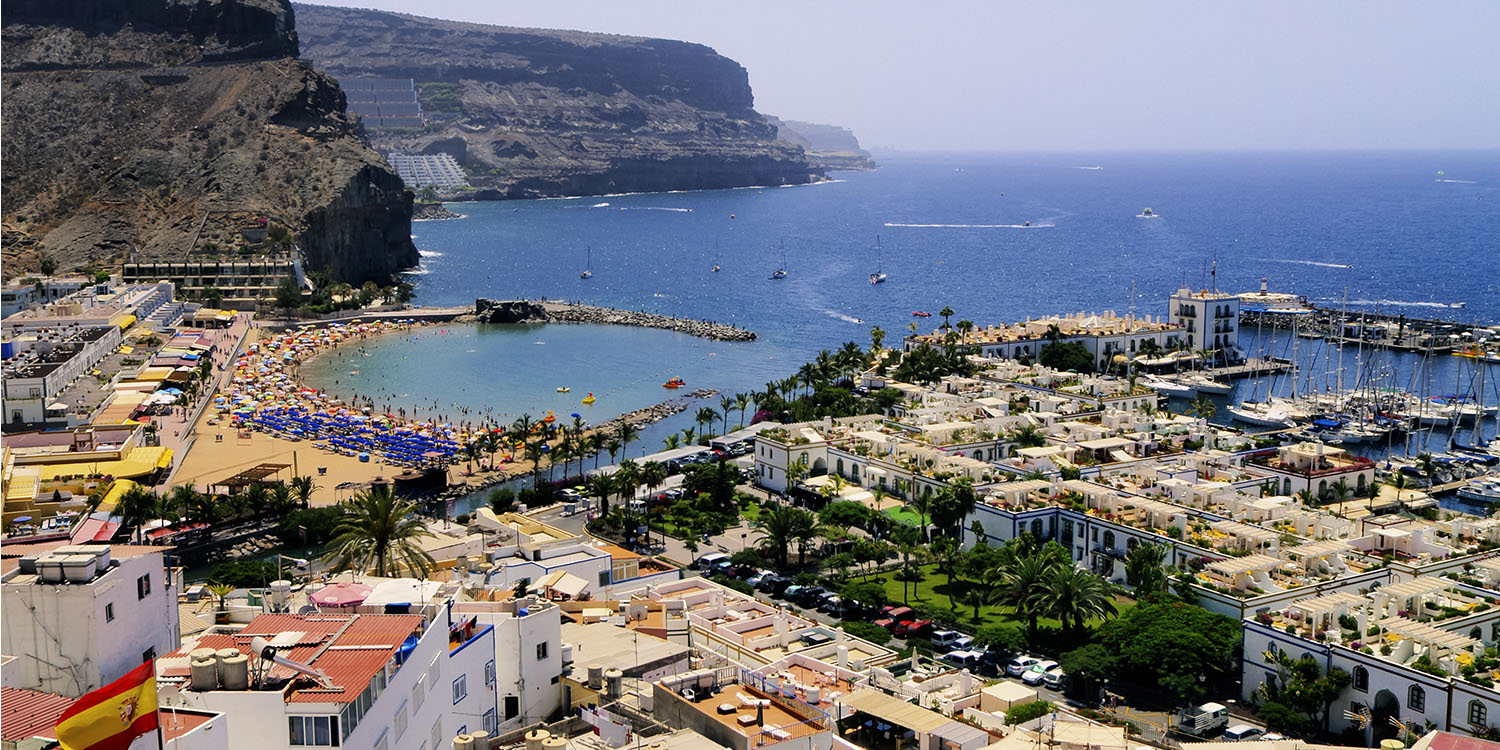01. “Puerto Mogan” of Gran Canaria
This charming port is also known as the “Little Venice” of Gran Canaria. It has a network of attractive canals connected by crossings and little bridges, which make for a very relaxing stroll around the port. This fishing village is made up of buildings of no more than 3 storeys, and was developed as a pedestrian village with colourful Mediterranean-style houses.
Puerto de Mogán is also ideal for excursions, especially on a Friday morning, when a large attractive market is held on the fishermen’s wharf. If you have children with you, there is a small protected beach to the east of the port. In addition, the superb marina with its chic restaurants, its cafes and its stylish piano-bars surrounding the fleet of busy local fishing boats, is the perfect place for an evening stroll or a romantic dinner to watch the sunset.
02. Puerto Rico and an encounter with dolphins
Puerto Rico, situated on the south coast of the island, is one of the most popular family resorts of Gran Canaria. Previously, it was no more than a small fishing port, but today it has become a very pleasant beach resort, with restaurants, shops, an attractive promenade, plenty of sun and wonderful natural scenery.
You will love the wonderful private beach, with its golden sand and its calm, clear waters, right in front of the main promenade! It is the perfect place to sunbathe as it is one of the sunniest places on the island. And, in addition, it offers an incredible choice of water sports. There are numerous species of dolphins and whales living in the underwater world around the island of Gran Canaria. Take the opportunity to watch them during your holiday! From the Puerto Rico harbour, you can take a number of excursions by boat, but we particularly recommend the dolphin-watching one. You will marvel at the sight of these wonderful marine animals.
03. Teror: the most beautiful village of Gran Canaria
Take a little journey into the past. Teror is probably the prettiest village in Gran Canaria, with its splendid historical houses, some dating from the 16th century. You will note the magnificent carved balconies of stone and wood.
Here you will find some of the best examples of colonial architecture, but life has always centred on the “Basilica de Nuestra Señora del Pino”, which dates from the 18th century, and is dedicated to the patron saint of Gran Canaria. The Basilica contains some impressive statues, some paintings, and the famous statue of the Virgin, carved in wood and richly dressed.
Every year on 8th September, the most important religious festival in the island’s calendar takes place, during which many pilgrims come to the island to pay homage to the saint.
04. Las Palmas, the capital city
To see the historic centre visitors should go to the popular area of Vegueta where some of the most important historical buildings have been standing for the past five hundred years: the chapel of San Antonio Abad, the Plaza de Santa Ana bordered by the Casas Consistoriales, the Obispado, the Casa Regental and Santa Ana Cathedral.
Vegueta also houses museums such as Casa de Colón (Christopher Columbus museum), where you can learn about the most interesting aspects of Columbus´ trips to America and his stopovers in Las Palmas de Gran Canaria. The Museo Canario contains the historic relics left by the former inhabitants of the island. The Museo de Arte Sacro (Museum of Sacred Art) also offers visitors an exhibition of several religious works. In contrast to the historic buildings in Vegueta, you can also visit the Centro Atlántico de Arte Moderna (modern art gallery) which is one of the most interesting avant-garde displays of works by Spanish artists.
It is worth missing a few hours of sunning on the beach to visit samples of traditional architecture, patios full of plants and plazas such as Pilar Nuevo, Santo Domingo and Espíritu Santo presided over by a beautiful stone fountain, wooden balconies and cobbled streets.
05. Vega de San Mateo
A walk around the old quarter of the Vega de San Mateo is unthinkable without visiting the Parish Church, located in the Calle Principal (High Street); a two nave building, whose central upper part is crowned by a bell tower, projected by José Luján Pérez, a great Canarian religious artist. The bell of the temple, put in place four years after its construction, was sent from Cuba by Canarian immigrants in that locality.
The Alameda or Public Walk of Santa Ana, situated next to the church, forms together with the Town Hall, a very refined neo-Canarian style group of constructions. The San Mateo agricultural and crafts Market, within the village, is one of the most popular places in the municipality, which nowadays has become the main economic engine of the locality. Public opening hours: Saturdays from 08:00 to 20:00 hours and Sundays from 08:00 to 15:00 hours.
A visit to the Vega de San Mateo also discovers unique panoramic views of the middle of the island and the Cumbres (the Mountain Peaks). Once in the Cumbre of Gran Canaria you can see Los Pozos de Nieves (The Snow Wells), where in the past the snow was stored and later transported to Las Palmas de Gran Canaria, where it was consumed in the form of ice lollies. As well as visiting one of the renovated wells, one enjoys the magnificent scenery of the protected natural space of the Cumbres.
06. Tejeda
Culture and art are present in Tejeda as additional options to tourism and leisure activities. Visitors may visit theAbraham Cárdenes Sculpture Museum where they can admire part of the important Canarian sculptor’s work. Abraham Cárdenes was born in Tejeda and was always a great admirer of his homeland. There is also an Ethnographic Museum, which allows the visitor to take a tour through the history of the municipality and of Gran Canaria. There will also be a Medicinal Plants Centre, where the visitor can discover the variety of plants, herbs and flowers which are autochthonous to Tejeda and the island. Besides you will be able to see the different uses these have in medicine, cosmetics and religion.
Tejeda is a must for those who wish to discover the rich archaeological wealth of the island. Archaeological remains such as burial caves, rock carvings, paintings and houses are found in this area. Roque Bentayga offers an excellent example. It is an outstanding natural element which was a sacred place for the native people. It was here that they gave offerings and prayed to their gods. The Cuevas del Rey are located inside the Roque Bentayga, where the visitor can see caves that were used as rooms and granaries, rock carvings, cave paintings and numerous perforations carried out in the rock demonstrating the existence of a pre Hispanic religious centre.
07. Agaete
In the historic centre there is the church Iglesia de La Concepción, which replaced the primitive chapel (1515) and gave rise to the first streets and town square of the municipality. With the building of the new parish church after a fire in 1874, a new residential area was created in the municipality. Opposite this the Plaza de la Constitución was built and nearby the principal old-style buildings of the town were also built.
Agaete also has some important green areas which are a must for visitors: el Huerto de las Flores (The Flower Garden) and theTamadaba Natural Park. The flower garden is actually a botanical garden in the town centre with a large variety of exotic plant species. It was a meeting place and somewhere to meditate for famous poets of the Canary Islands such as Tomás Morales, Saulo Torón and Alonso Quesada. The Tamadaba Natural Park is a protected area at the highest altitude of Agaete (1.180 metres), with the largest pine forest in Gran Canaria.
Another particularly pleasant visit is a stroll through Puerto de Las Nieves, the coastal area of the municipality. This is the location of the Chapel and the Triptych of Our Lady of the Snows, attributed to the sixteenth century Flemish painter Joos Van Cleve.
08. Agüimes
Agüimes offers a variety of leisure attractions for visitors, whether it is strolling through the historic centre, green areas and natural landscapes, or taking part in the different cultural activities that are held throughout the year.
One of the most interesting visits for tourists is to the Parish Church of San Sebastián, a stone building in the style of a cathedral, with a façade which is one of the best examples of Canary Islands neoclassical architecture. It was declared a National Artistic Historic Monument in 1981. In the plaza de San Antón there is the Agüimes Interpretation Centre, which enables visitors to understand the architectural, artistic and historic features of the Historic Centre, the different types of buildings that exist or once existed there, such as the rural houses, the houses of the bourgeoisie, craft workshops, chapels, churches, convents and archaeological sites.
For those who wish to see the natural area of the municipality there are two places that must not be missed: Temisas and Guayadeque.
09. Maspalomas
The Maspalomas Lighthouse is in the south of Gran Canaria, right in the middle of one of the most visited sections of coastline in Europe. Maspalomas, Playa del Inglés and Meloneras offer a vast number of hotels and apartments, loads of leisure options during the day and an attractive night life around the beaches. People out walking, surfers and nudists mingle freely on a beach which also has quiet, isolated areas for nude bathing.
However Maspalomas is not just known for its enormous expanse of dunes next to the sea, or its great climate. It is also known for its old Lighthouse, which saw the first tourists arrive, and witnessed the area turn into a holiday resort. Ever since it dawned on the first travellers that the warm temperatures were no fluke on this endless beach, the Maspalomas Lighthouse has been the silent witness to thousands of days of sun, honeymoons, dips in the sea and strolls along the promenade.
The decision to build the lighthouse was made in 1861, although it actually took 28 long years to finish. At the time, the place was an uninhabited, desert paradise, cut off from the rest of the island. In order to build the lighthouse, which stands 55 metres high, they used a dock with a small ramp to unload the materials, which could only be brought in by sea.
10. Arucas
The city of Arucas is a district that offers important architectural and urban assets. The city centre, declared a site of historic-artistic interest, is a place visitors must not fail to see.
The Parish Church of San Juan Bautista the leading architectural and social monument in the municipality. It was built entirely in Arucas stone by local master masons, and it dates from 1909. Apart from the wealth of the carved stone columns and column heads, there are also some beautiful stained glass windows, the works of Canary Island painter Cristobal Hernandez de Quintana, and an extraordinary carving of the Reclining Christ, by Manuel Ramos.
Plaza de la Constitucion is the site of the Town Hall and the Municipal Market. Both these buildings are great architectural Works, as is the Cultural Centre, a traditional 17th century Canary Island house that includes an inner courtyard with balconies and a magnificent specimen of a dragon tree. This building now holds the Library and the General Archives.
The Gourié House, built in the early 19th century, is an old house from the Feudal Estate of Arucas that now houses the Arucas Municipal Museum and the Tourism Office, surrounded by extraordinary ornamental gardens.
An outstanding feature of Arucas is the Rum Museum and Factory, founded on 1884, which can be visited at any time and is considered one of the historic buildings of the municipality, due to the tradition of rum making in the town. The warehouse, one of the most important of Europe, has been visited by numerous personalities that have left his paragraph in the casks of oak.







